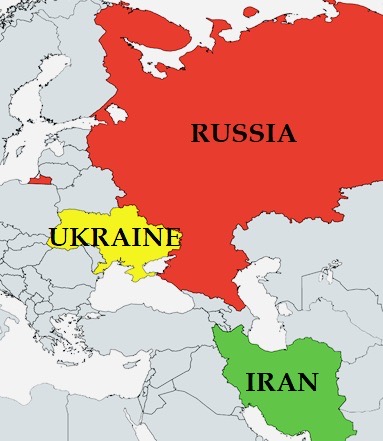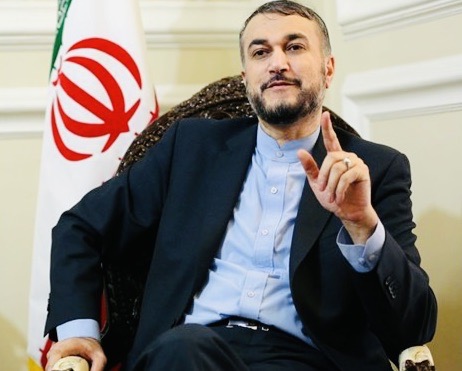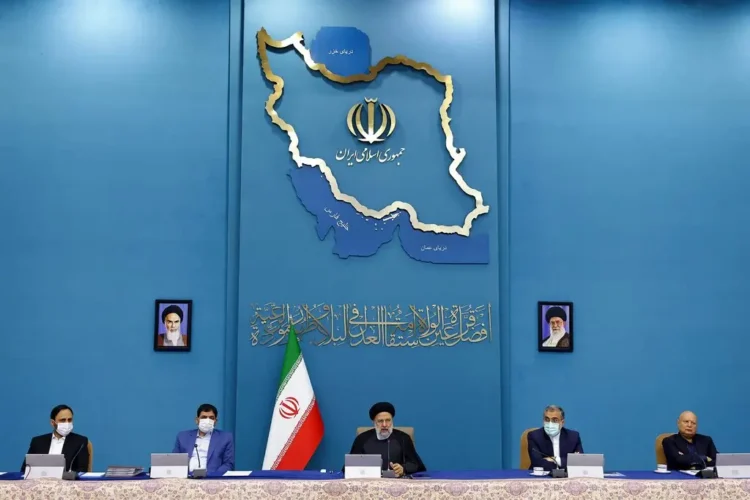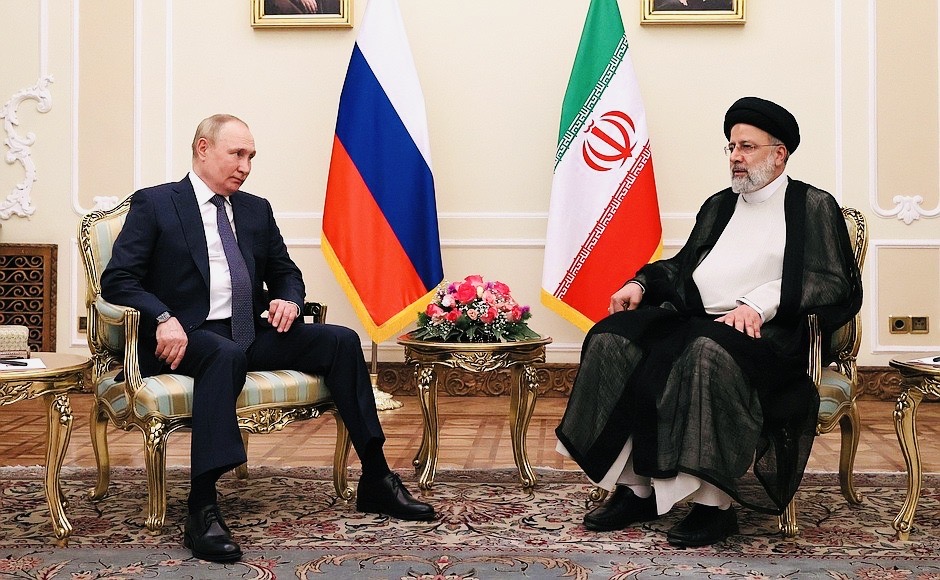The brief rebellion staged by Wagner mercenary warlord Yevgeny Prigozhin in Russia on June 24 has probably weakened Russian President Vladimir Putin and tarnished his reputation as a paragon of stability and continuity. But it will probably have no discernible effect on Russia’s foreign policy, particularly its rapidly expanding relations with Iran, Israel’s chief enemy.
Shortly after Prigozhin’s 36-hour insurrection petered out, Iranian President Ebrahim Raisi, who last visited Russia in 2022, called Putin and offered him “his full support,” the Russian government reported.
Nothing less was expected from Iran, one of Russia’s closest allies in the Middle East. Since its invasion of Ukraine in February 2022, Russia’s military, economic and political cooperation with the Islamic Republic of Iran has ballooned, much to Israel’s concern. Prigozhin’s uprising will likely not alter Russia’s multifaceted relationship with Iran.

The Iranian regime regards Putin as a dependable leader who has maintained cordial ties with Iran for decades. Iran and Russia are both at odds with the United States and Western powers, such as Britain and France, over Ukraine.
Iran’s supreme leader, Ayatollah Ali Khamenei, has invited Putin to Tehran five times and has expressed support for Russia’s aggression against Ukraine. He told Putin that if he had not attacked Ukraine, “the other side would have initiated a war.”
Just two weeks before Prigozhin staged his revolt, which forced him into involuntary exile in neighboring Belarus, Russia’s close ally, the United States disclosed that Iran is helping Russia build a drone factory in the Yelabuga region, several hundred kilometers east of Moscow.
Iran has provided Russia with hundreds of drones, including the Shahed-136 drone and the Mohajer-6 reconnaissance and strike drone. Last November, Iran shipped artillery and tank rounds to Russia. Since then, Iran has sent Russia some 300,000 artillery shells and one million rounds of ammunition via the Caspian Sea, according to The Wall Street Journal.
As well, Iranian military personnel have been dispatched to the Crimean Peninsula to train Russian soldiers in the use of drones.
Russia has deployed drones to attack Ukraine’s critical infrastructure as part of its plan to break its morale. Drones have also struck civilian targets, especially high-rise apartment buildings in cities such as Kyiv, Zaporizhzhia, and Odessa. Although Ukrainian missile defence batteries have shot down the majority of these drones, they have been devastating in terms of the fear, anguish and suffering they have inflicted on the Ukrainian civilian population.
Russia turned to Iran as a supplier when its own stocks of drones reached near depletion levels. Strangely enough, Russia appears to have no satisfactory capacity to manufacture drones in sufficient numbers. Since Iran seems to be the only country willing to help Russia in this respect, Putin turned to the Iranian regime for assistance.

In exchange, Russia has offered Iran “unprecedented defence cooperation,” according to John Kirby the National Security Council spokesman in the White House. Russia has agreed to sell Iran SU-35 fighter jets, ballistic missiles and cyber warfare surveillance software. Iran is reportedly seeking attack helicopters, combat trainer aircraft and radar from Russia. These and other issues were discussed when Iranian Foreign Minister Hossein Amir-Abdollahian visited Moscow at the end of March.

Kirby described Russia’s cooperation with Iran as “a full-scale defence partnership that is harmful to Ukraine, to Iran’s neighbors and to the international community.”
By all accounts, more than 20 countries have expressed an interest in buying Iranian drones.
Iran, like Israel, has bet on drones as a strategic military asset, and has provided them to key surrogates in the Middle East in a bid to extend its influence in the region. Over the past few years, Iran has transferred drones to pro-Iranian militias in Syria, Hezbollah in Lebanon, Hamas and Islamic Jihad in the Gaza Strip, and Houthi rebels in Yemen.
Iranian drones have been largely effective.
Four years ago, the Houthis fired a barrage of drones at Saudi Arabia’s oil processing facilities, causing extensive damage. Last year, Iranian drones struck a Saudi frigate in the Red Sea and Kurdish bases in Iraq. Last July, Israel downed three Iranian-made Hezbollah drones approaching its gas fields in the Mediterranean Sea.
Iran’s growing closeness to Russia comes on the heels of a strategic decision by its current president, Ebrahim Raisi, to turn eastward in terms of its foreign engagements and commitments.

Iran and Russia already coordinate closely in Syria, which is still embroiled in a civil war after 11 long years. It should be recalled that Russia upgraded its military profile in Syria in 2015 at the behest of Qassem Soleimani, the late commander of the Islamic Revolutionary Guards Corps. He was killed by U.S. drones in Baghdad airport in January 2020.
Despite their competing interests in Syria and Russia’s attempt to marginalize Iran’s role and influence in Syria, Moscow and Tehran staunchly support the Syrian regime of President Bashar al-Assad. Russia, too, has agreed to add Iran to the Astana political process on the future of Syria.
Whether Russia’s partnership with Iran will impact Israel’s ongoing air campaign in Syria and its security cooperation with Russia remains to be seen. For the past decade, Israeli aircraft have been regularly bombing Iranian military bases in Syria with Russia’s quiet acquiescence. Israel has also struck Hezbollah arms convoys en route to Lebanon.
Israel’s coordination with Russia in Syria could well come to an end. As Israeli analyst Nadav Pollak has written, “The bottom line is this: not far into the future, Iran will receive something in return for its indispensable military generosity toward Russia, and Russia will have many ways to return the favor that could impede Israel’s security. When the day comes, Israel will have limited means to respond to this new regional reality, so it must be prepared to the greatest extent possible.”
On the economic front, Russia and Iran regard each other as intrinsic partners. Russian exports to Iran rose by 27 percent last year, and Russian imports from Iran increased by 10 percent. Both sides have agreed to trade in currencies other than the American dollar.
In 2018, Iran was removed from SWIFT, a Belgian messaging service that links more than 11,000 financial institutions around the world. Since January, however, they have integrated their banking systems in response to Western economic sanctions. Iran is now linked to Russia’s global messaging service, which allows the Iranian government to bypass the Western-oriented banking establishment.
Due to the war in Ukraine and the imposition of Western sanctions, Russia has shifted its trade routes southward. In light of these factors, Russia and Iran have been working to develop the 7,200-kilometer-long North-South Transport Corridor, which was conceived by Russia, India and Iran and will stretch from the Persian Gulf to the Baltic Sea.
Last month, Russia and Iran signed a $1.6 billion agreement to build a 162-kilometer railway line in Iran. It will be part of the North-South Transport Corridor, which has been touted as a rival to Egypt’s Suez Canal.
Last June, Russia and Iran signed a memorandum to set up trade centers in St.Petersburg and Tehran. Around this time, Russia announced it would invest $40 billion in Iranian natural gas projects.
Russian-Iranian relations are clearly on the upswing, thanks in large part to the war in Ukraine.
